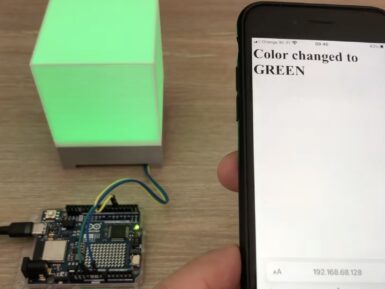
Overview
The RCWL-0516 is particularly suitable as an alternative to using a PIR motion sensor.
When it detects a moving object, the output changes from a low logic level to a high level (3.3 volts). Appropriately interfaced (Arduino, Fishino or other), it can be used for the automatic opening of electric doors and gates, automatic lighting.
Detection range is about 9 meters.
Tech specs
- Power supply: from 4 volts to 28 volts
- Consumption: typical 2.8 mA; max. 3 mA
- Detection distance: from 5 to 9 meters
- Transmission power: typical 20 mW; max. 30 mW
- Output voltage and current: 3.2-3.4 volts - 100 mA
- Operating temperature: from -20°C to +80°C
- Pin definition: 3V3: 3.3 volt output voltage
- GND: negative power supply
- OUT: when it detects a moving object, it changes from a low level to a high level (3.3 volts)
- VIN: positive power supply from 4 volts to 28 volts
- CDS: if kept low, less than 0.7 volts, the output will always be low even in the presence of motion
Conformities
Get Inspired

Syntaxx is powered by three Arduino boards, each handling specific functions to create a seamless and dynamic performance:

It can be tough to get started with building an Internet of Things (IoT) project from the ground-up, as getting connected, serving a webpage, and managing other devices can all be a challenge to a beginner. This is why the YouTuber known as “Mario’s Ideas” made an end-to-end tutorial that details everything one might need to build a smart RGB lamp. Because the Arduino UNO R4 WiFi contains an ESP32-S3 chip for its Wi-Fi radio and Renesas RA4M1 microcontroller, it was the perfect candidate. Mario’s sketch begins with a call to initialize the Wi-Fi module before attempting to connect to his local access point. Once finished, it enters a loop that continuously checks if a client has connected to the web server, and if one has, reads the requested path while also seeing if the string contains “/H” to denote an “ON” command to set the LED. Toggling an LED is useful, but Mario wanted to take things a step further by building a tangible — in this case a lamp. His 3D-printed enclosure features a recessed base and translucent cube for diffusing the light emitted by a grid of NeoPixels. Controlling the color was just as easy since any browser could still send a request path containing a color and get back the lamp’s updated status. To see more about this IoT lamp project, you can watch Mario’s video below!







